In This Issue....
From the Editor:
Unfinished Business
FIDO: Leevan Etok
Fan MailIn the News
Happy Tenth Anniversary, ISDI
Sledge Dog Memorial Fund Update
Inuit Dog Research Project Underway
The Canadian Animal Assistance Team
The Chinook Project Goes to Cambridge Bay
Hints and Tips: Building a Dog Box, Pt. 1
Navigating This
Site
Index of articles by subject
Index
of back issues by volume number
Search The
Fan Hitch
Articles
to download and print
Ordering
Ken MacRury's Thesis
Our
comprehensive list of resources
Talk
to The
Fan Hitch
The Fan
Hitch home page
ISDI
home page
Editor's/Publisher's Statement
Editor: Sue Hamilton
Webmaster: Mark Hamilton
The
Fan Hitch, Journal of the Inuit Sled
Dog, is published four times a year. It is
available at no cost online at:
https://thefanhitch.org.
The Fan Hitch welcomes your letters, stories, comments and suggestions. The editorial staff reserves the right to edit submissions used for publication.
Contents of The Fan Hitch are protected by international copyright laws. No photo, drawing or text may be reproduced in any form without written consent. Webmasters please note: written consent is necessary before linking this site to yours! Please forward requests to Sue Hamilton, 55 Town Line Rd., Harwinton, Connecticut 06791, USA or mail@thefanhitch.org.
This site is dedicated to the Inuit Dog as well as related Inuit culture and traditions. It is also home to The Fan Hitch, Journal of the Inuit Sled Dog.
The Fan Hitch welcomes your letters, stories, comments and suggestions. The editorial staff reserves the right to edit submissions used for publication.
Contents of The Fan Hitch are protected by international copyright laws. No photo, drawing or text may be reproduced in any form without written consent. Webmasters please note: written consent is necessary before linking this site to yours! Please forward requests to Sue Hamilton, 55 Town Line Rd., Harwinton, Connecticut 06791, USA or mail@thefanhitch.org.
This site is dedicated to the Inuit Dog as well as related Inuit culture and traditions. It is also home to The Fan Hitch, Journal of the Inuit Sled Dog.
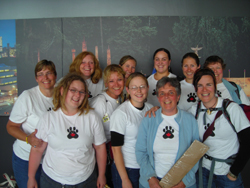 |
The Canadian Animal Assistance Team
According to their website, "The Canadian Animal Assistance Team (CAAT) is … dedicated to providing veterinary medicine and humane education for needy animals worldwide. Now, CAAT is developing its volunteer base and the organizational infrastructure necessary to be able to respond rapidly to future catastrophic disasters and other worthy relief and humane education projects around the world."
The following telephone interview took place on Sunday, August 27, 2007 between Sue Hamilton of The Fan Hitch and CAAT founder, Donna Lasser, a Registered Animal Health Technologist in Vancouver, British Columbia, Canada.
T.F.H.: Who are the people of the CAAT?
D.L.: We are Canadian veterinarians, veterinary technologists, technicians and assistants.
T.F.H.: Are you folks associated with a particular veterinary school?
D.L.: No, we're not. We're a registered charity here in Canada. We have approximately 175 members all across Canada.
T.F.H.: When did CAAT begin?
D.L.: We started in response to hurricane Katrina, September, 2005. Just within three or four days after the hurricane, a couple of us at work decided to go down and see if we could help out in New Orleans, Louisana, USA. We happened to have an interview on local TV here in British Columbia and the money just began flooding in from the Canadian public! Enough money came in for us to send eighty-two veterinary professionals down and work in New Orleans over a period of about five weeks! It was incredible and quite an experience. And since then different countries in the world have heard about us and that we're a veterinary group. The first country that contacted us was on a remote island in Fiji. We went there in April, 2006 and we're going back in February, 2008 to follow up. We've been invited all over the world. We've been to Trinidad, Guyana in South America, Northwest Territories and to Nunavut recently.
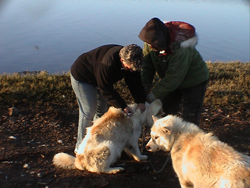 |
A
CAAT team member vaccinates a sled dog as its owner
assists.
Photo courtesy of CAAT
T.F.H.:
How
did you end up on that mission to northern Canada? Did you
ask to go or
were you invited? Photo courtesy of CAAT
D.L.: We don't solicit invitations. We only go to areas where there are no veterinary services available. We receive about two invitations a month from somewhere in the world. We've been trying to get more Canadian projects but it's really difficult to do here in Canada because we're so well serviced all over the country by veterinarians.
T.F.H.: Not up north!
D.L.: Right, and that's the only place we can go. Unfortunately the costs to go there are very prohibitive. From Ottawa to Igluliq, where we went in Nunavut, was $4000 per ticket. Thankfully, the airline gave us 75% off per person. Eleven of us went, invited by a concerned resident in the community. They had a dogsled race, the Nunavut Quest, in April this year and a lot of the dogs came back and died of distemper. If the government of Nunavut or of Canada wants to keep that breed of dog - it's a very distinct breed, a beautiful dog - I don't know why they can't provide vaccines to all these communities. There are only twenty-six communities. I am sure that the vaccine companies would even help them out by donating some.
So that's the main reason we went to Igluliq. This concerned resident got the mayor of the hamlet and the senior administrative officer on board, and we received an official invitation from them to come. It wasn't to do spays and neuters because we don't want to spay and neuter that breed out of existence. We would selectively spay and neuter maybe some of the older ones or ones that maybe have mammary tumors. And that's what we did. A lot of other breeds, mixed breeds we just spayed and neutered if the owners wanted that. We did get all the dogs in the community, including all the dog teams, vaccinated twice (it included the booster) while we were there and rabies vaccinations were also given plus all their deworming were done. It was a great experience!
T.F.H: What were you using for a wormer?
D.L.: We use what's called Droncit because there's a fish tapeworm that dogs get. Droncit is the only kind of wormer that gets the Echinococcus tapeworm. And that's very transmissible to humans.
T.F.H.: And that's why the Inuit Sled Dog International is trying to encourage the establishment of veterinary clinics, because it's not only a case of the health of the animals but human health as well.
D.L.: Oh, for sure. I don't know if that's going to happen any time soon. When we were in Iqaluit at the airport we happened to meet a girl that was just heading off to Saskatoon to veterinary school. She was an Inuit woman, probably the first Inuk veterinarian that will graduate in Canada. She's coming back to Iqaluit to work. I don't think there are any vets in Nunavut at all.
Our vets have passed written exams that are totally national. Across Canada their license is supposed to be good. However, while we were in Igluliq we found out that our veterinarians were supposed to be licensed to practice in Nunavut for the two weeks we were there. And it costs $200 a year to license each vet. Nunavut was hassling us about that. It was the registrar in charge of licensing for all professionals who got wind that we were there. We're going to try contacting Ottawa and go higher up to see if we could get those fees waived every time we go because we can't expect our veterinarians to pay that fee and CAAT can't pay it either.
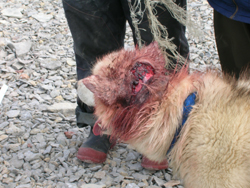 |
The
dog fight wound is not fresh and not looking good. But
thanks to CAAT,this dog is about to get life saving
medical attention. Photo courtesy of CAAT
T.F.H.:
I
guess most of your team members had never been in the
North. thanks to CAAT,this dog is about to get life saving
medical attention. Photo courtesy of CAAT
D.L.: No, none of us had.
T.F.H.: So your team wasn't familiar with Inuit culture, sled dogs in general and Inuit Dogs in particular.
D.L.: No. We didn't know what to expect. The woman that called us there tried to prep us a bit on culture and what she had experienced over the last three years. And that helped a lot. But most of it we learned by trial and error. We had a team of all women. There were three veterinarians and the rest technicians. We're a pretty laid back team. There aren't any of us that are aggressive. So we let the people come to us and start talking. We didn't push anybody, push them to do anything to their dogs. We would make recommendations it but we didn't say, "Oh, you're a bad owner if you don't do certain things.
T.F.H.: Because of CAAT's good works in the North, the Inuit Sled Dog International is going to send you a copy of Ken MacRury's masters thesis, The Inuit Dog: Its Provenance, Environment and History and Geneviève Montcombroux's book The Canadian Inuit Dog: Canada's Heritage, our gifts to you, for a better understanding of the breed. And I will email you a link to The Inuit Way. It's wonderful publication whose purpose is to teach people all about Inuit culture.
D.L.: Awesome! Thanks!
When we arrived, within a couple of days we were able to get on the community radio station and have a call in show. We had a translator there. And the first two questions were really interesting. The first caller was an elderly woman who asked, "Why are you here to help the dogs? Are they more important than us older people? We're not getting the health care we need up here, but you're coming to help the dogs." The second one was a man who asked, "Have these vaccines been tested on dogs anywhere else in the world or are our dogs the guinea pigs?" I think that show really cleared up a lot of mistrust and we made it known that we were volunteering to be there. The government didn't pay for us to come. We paid our own way to go there. And we just wanted to help. And they just couldn't understand that. But after that people were so much friendlier and brought their dogs in, sometimes just for exams or a check up. It was really great. But I know there was a lot of mistrust at first.
We also spent an evening with the Elders' Society. The Elders, I am sure you know, are a huge part of the Inuit culture. We asked for a meeting with them. That was really great. We thanked them for letting us be in their community. One Sunday a bunch of us even went to church. I think they appreciated that.
And we sure supported the carvers! Bought a lot of carvings.
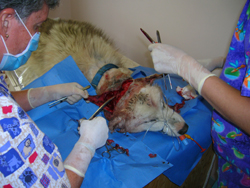 |
The
wound has been debrided of dead tissue and is now ready
to be closed.
An endotracheal tube is inserted down the dog’s windpipe to assure
unobstructed breathing during surgery. Photo courtesy of CAAT
T.F.H.:
How
long were you in Igluliq? An endotracheal tube is inserted down the dog’s windpipe to assure
unobstructed breathing during surgery. Photo courtesy of CAAT
D.L.: We were supposed to be there two weeks but we were there two weeks and two days because our flight couldn't get out due to poor weather.
While we were there we received six other invitations by phone and by email from other Nunavut communities asking us if we could please come and help them because their dogs were dying too. It was so sad.
T.F.H.: So you did a little bit of everything: spaying, neutering, vaccination and worming. Would part of you mission be to teach some first aid and things like that?
D.L.: Yes, if people are interested. We had quite a few of the residents come in and watch us during surgery, especially the children. They loved to gather around and watch and ask questions. Their English is pretty good and we hope we inspired them to go on to higher education.
We did have a couple of really neat cases. One dog we neutered had a really rotten canine tooth and after working on the tooth for about an hour we finally got it out. We didn't have many [dental] instruments, just a pair of extractors and that was it. I'm sure that gave him a lot of relief. Another dog belonged to the wife of one of the sled dog owners. She came to us one morning and said, "My husband is going to shoot my dog today because he got into a fight and the whole back of his neck is ripped open." And so we asked her to bring the dog to us and we'd have a look. She talked her husband into going to get the dog - it was about an hour away - and bring him in. It was the nicest dog and I can see why she was in love with him. His neck was ripped from side to side right down to the muscle. We anesthetized him and for two hours had two vets working on his neck and suturing him up. It was quite a mess. We put a drain in and gave him tons of long acting antibiotics and pain medication. We went back every day to his house to check him out and give him an anti-inflammatory. We took his drain out after four days and then took his sutures out before we left and he was healed up beautifully. The woman was so grateful. Ever since we did that she did special things for us, like almost every day she'd come and visit us and she'd sit and tell us stories about the Inuit people. She had us over for a meal of arctic char. It was just amazing. We played games. She gave us treasured little things that she had. Her husband was of course happy, too, that he didn't have to put the dog down. Things like that were really meaningful.
 |
The
wound is so deep that absorbable sutures were needed
within the muscle layer. Photo courtesy of CAAT
T.F.H.:
Inuit
Dogs are remarkably tough. They can suffer some incredible
fight
wounds from which they can heal. within the muscle layer. Photo courtesy of CAAT
D.L.: But they're a little wimpy, though. They're like the husky breeds. No breed is worse than huskies for being wimpy. Just giving these Inuit Dogs injections, their vaccines, they all screamed! We never saw that in the other breeds at all.
T.F.H.: What kind of help did you find that the owners and their dogs needed the most?
D.L.: Mainly just the vaccinations. There was a By-Laws Officer there up until last fall and then he moved. He was giving all the dogs rabies vaccines. The government provides those because of the public health risk. The distemper-parvo vaccine, they didn't have that at all. So we'd go out with the team owners. The owners would introduce us to their dogs and hold them while we got them all vaccinated and wormed them. I think that vaccinating could be done by someone in the community. Veterinarians don't have to do it, as long as the dog is not obviously sick.
Of the twenty-six communities, if there could be one or two main contact people, that's what we'd like to get going. Vaccines could be sent to them on a yearly basis. And they could make sure that all the dogs were vaccinated.
T.F.H.: Did you find any non-indigenous, non-working, pet dogs while in Igluliq?
D.L.: Yes. I'd say about half and half perhaps. A lot of Inuit Dogs were not actually in a team but were tied up outside the homes. There were a lot of smaller dogs like beagles, corgi crosses, a German Shepherd or two.
T.F.H.: Those are the ones that need to be neutered. There's so much contamination of what few pure dogs are left.
D.L.: Oh, for sure.
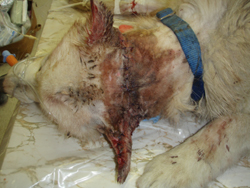 |
At
last! Now healing can begin.
Photo courtesy of CAAT
T.F.H.:
Where
is CAAT headed off into the north next? D.L.: We have started an Ontario chapter of CAAT. There are about thirty members and they are going to be in charge of Nunavut because they're closer to it and that makes more sense financially. And they're going to be in charge of northern Ontario also. They are already responding to some communities for next year. They are hoping to go into Iqaluit and then branch off to three or four other communities with one or two vets per team: Pond Inlet, Clyde River, Dorset, Pangnirtung. They're trying to get something going for next summer.
T.F.H.: What about missions to Nunavik? Has anyone in Nunavik approached you? They certainly need the same help that Nunavut does and some communities in Nunavik are starting the revival of the pure Inuit Sled Dog there.
D.L.: Nobody from Nunavik has contacted us. I'll have to keep that in mind. Do you have a contact person there?
T.F.H.: I will get you some names.
D.L.: If you could email me with any contact in the north that would be great.
T.F.H.: Are there any opportunities for Inuit Dog enthusiasts who have veterinary skills to join your missions?
D.L.: Possibly. As of right now we've only been taking Canadian citizens/residents as that's what we have written in our by-laws.
T.F.H.: My goodness, you guys are fantastic! You obviously see that there is a need for veterinary services established. ISDI has been hoping to have at least veterinary visits to the North to help people and their dogs. They need it and now you know they need it. By telling your story maybe we can get more interest and, most of all, convince the governments up north to establish veterinary clinics and systems to help the distant communities as is done in Greenland where the veterinarian, who has a permanent clinic in Ilulissat, has contacts in each of the other communities to perform some services when she cannot be there herself. We can't tell them what to do, of course. But is there any way that CAAT can be an advocate to encourage the governments to establish centralized facilities? If you could help with that or speak on behalf of that, especially from the standpoint of zoonotic diseases, you will have accomplished Nobel prize winning stuff!
D.L.: For sure we could be. I think that's what we're trying to focus on wherever we go, the public health issues. It seems to be more well received if we do that rather than just going in for the sake of the dogs.
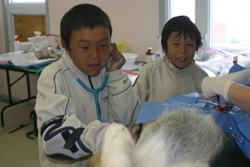 |
While
Randy observes, Hubert "monitors" an anesthetized female
dog's
heart rate and breathing as she is spayed. Photo courtesy of CAAT
T.F.H.:
I
know you're leaving tomorrow morning for Peru in the
aftermath of
their terrible earthquake. We wish you the best of luck.
We want to
stay in touch and learn more about your missions. And
anytime you've
got news of future Arctic missions or things you would
like us to pass
along or publicize to our worldwide readership, please
stay in touch!
Thank you so much for your time, for the photos and most
of all for the
work you're doing up north. It means a lot to the people
and the future
of the pure Inuit Dog, which you know is severely
endangered. heart rate and breathing as she is spayed. Photo courtesy of CAAT
D.L.: For sure. They're beautiful dogs and we don't want them to go extinct, that's for sure.
To learn more about CAAT, see photos of CAAT's mission to Igluliq and learn how you may help, visit http://www.caat-canada.org.